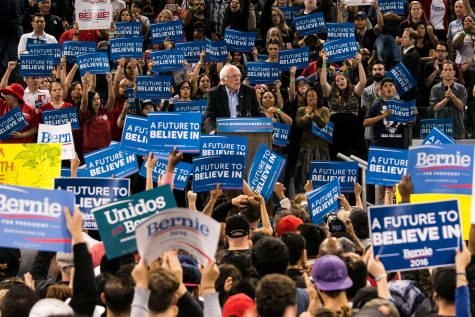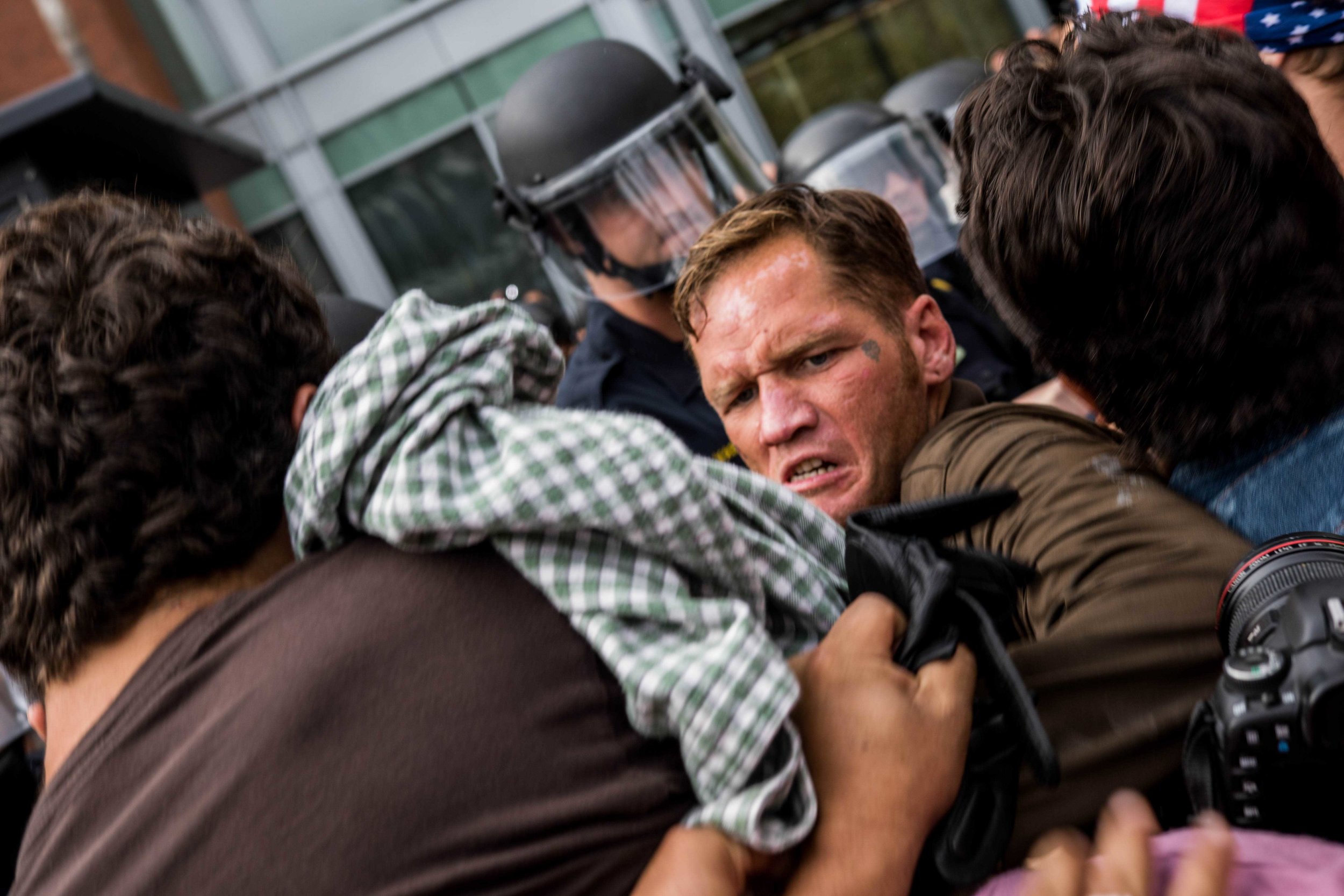The Madness of the 2016 Election Rallies
By Christian Monterrosa and September Dawn Bottoms
Anti-Clinton Protesters awaited Hillary supporters outside of a rally in Los Angeles, Calif. on Thursday May 5, 2016 (Chris Monterrosa)
We are told that we have freedom of speech, freedom of the press, and the right to peacefully assemble. While this holds true, our expressive freedoms often come with the aggressive and sometimes violent disagreement of others. This 2016 presidential campaign has caused an uproar among opposing supporters unlike anything seen since the late 1960s, when Martin Luther King Jr. and Senator Robert F. Kennedy were assassinated over political disagreements. Two candidates in particular, Senator Bernie Sanders and Donald Trump, seem to attract supporters with radical viewpoints, while Hillary Clinton supporters, in hopes of expanding upon progress made by the Obama administration, watch from the sidelines.
Living in a democracy, we can expect politicians to lobby for the support of citizens by means of appealing to their needs. When a scarce job market and a student loan deficit of over one trillion dollars exhausts middle class America, it becomes effortless for candidates to propose extreme political ideologies, which in turn appeal to extreme supporters. Naturally, political views on polar opposites like mass deportation versus a pardon on current illegal immigrants, will result in acute contention and political unrest.
By attending multiple rallies hosted by Clinton, Sanders and Trump, respectively, The Corsair was able to experience this pandemonium first hand.
When we first took on this daunting political beat, our goal was to create a simple profile on each running candidate and their politics in order to inform our student body. However, after attending the lawless Donald Trump rally in Costa Mesa, it quickly became clear that the story was no longer the candidates themselves, but rather their supporters and the chaos they were surrounded by — or causing.
Bernie Sanders, a candidate seen as an unwavering socialist who has gained massive support among the Santa Monica College community, held rallies in Santa Monica, Carson, and many other cities throughout Southern California to prepare for the June 7 primary. Sanders supporters of every stripe gathered in anticipation. An overall warm, uplifting mood spread like wildfire as supporters sprawled out on the grass, painting Bernie signs and hashing out the details of his presidential plans. The never-ending lines of supporters chanted things like, “feel the Bern” and “we love you Bernie.” With the camaraderie among supporters commonly found at most Bernie rallies, coverage by the media was almost non-existent, being that a story embracing the positive side of the campaigns doesn’t entice an audience.
Bernie fans were filled with such bliss during Bernie rallies, but this stood in stark contrast to their judgment, hatred, and violence-filled protests outside of both Trump and Hillary rallies. “Feel the Bern” turned into literal burning of Trump campaign signs. “We love you Bernie” evolved into “fuck you Hillary” outside of a Clinton rally held at East Los Angeles College on May 5. Anti-Hillary protesters, including devout Bernie supporters and the Brown Berets organization, were waiting for their chance to confront the attendees. Lined up alongside the exits, the protesters hurled hateful remarks and insults to exiting Hillary supporters.
Although these agitations did not result in physical altercations, anti-Hillary demonstrators were clearly looking for a fight. Inside ELAC, everyone remained civil, with the exception of a few instigators who were escorted out. With Clinton holding a steady lead in California, protesters questioned the willingness from her supporters to turn a blind eye to the current FBI investigations and her confusing changes of heart when it comes to the legalization of gay marriage, her involvement with Wall Street, and her exaggerated description of what happened in Bosnia.
At the Trump Rally In Costa Mesa, civil debates were not an option as violence erupted between Trump supporters and anti-Trump protesters, some of whom were Bernie supporters. Unable to present concrete reasons as to why they were demonstrating against Donald Trump, “I’m just here for the experience” became a common statement among this new generation of political activists.
An anti-Trump protester participating in the riots that night said, “To be honest, most of these people feel outcast and rejected, and that gets them angry.”
At the same time, other protesters felt that Trump is a racist and a bigot, referring to his generalization of illegal immigrants as “rapists” and “criminals.” These controversial and “politically incorrect” statements tend to appeal to a radical demographic that still exists within America. One woman in the Costa Mesa rally audience berated a Hispanic man recording video on his phone and yelled, “You just wait until Trump becomes president, you’re going to wish you were in hell.” Cole Bartiromo, a Trump supporter, was punched in the face after calling protesters “illegal scum,” making headlines across multiple news outlets.
With a strong media presence at every rally, the opportunity to broadcast opinions only escalates the actions of demonstrators and supporters, often magnifying the severity of the situation by those hoping to document something newsworthy.
Like the media, law enforcement officials have overcome the learning curve, increasing security at every rally along the way. Designated protest zones, police on horseback, and swat teams are only a few ways in which police have adapted to the violent outbursts that shadow this presidential campaign. Many protesters have faulted the police for the increase in force, claiming things like “you’re supposed to be protecting us” and expressing an overall tone of mistreatment. However, this interpretation fails to recognize that police are responding to violence rather than creating it and overlooks the passion-driven instigation towards them — passionate instigation that, interestingly enough, reflects the ideologies and personalities of the candidates they support.
Bernie Sanders supporters seek freedom from a society which they deem unfair, much like Sanders’ declared war on Wall Street. Bernie’s aesthetic of a systemic “revolution” inspires his supporters to do just that: revolt.
Trump supporters show a scary resemblance to the Republican candidate, often repeating his controversial statements verbatim and carrying a confrontational demeanor, much to the approval and encouragement of Trump himself.
Hillary Clinton supporters, meanwhile, remain calm and collected, staying out of the riotous fights between competing parties, mirroring the neutral mindset of Secretary Clinton. Having become experts at playing defense, it was hard to find any Hillary supporters at the aforementioned protests.
Looking ahead, the presidential campaign sits at a dramatic fork in the road. In one direction lies just another election year, with all of the current turmoil finding itself buried in the history books. In another, the potential to repeat the violence of 1968, if not raise the bar.


